

What is the most neglected area of the entire northern sky? The north polar region, of course — especially for anyone who owns a German equatorial mount. It's a shame because, as Scotty reminded us, one advantage of living in the north temperate zone is that the polar region of the sky is available every clear night of the year. But Scotty had a way to solve this problem so that we could turn our sights to this rich but overlooked area. "Observers using equatorially mounted telescopes may find it difficult to sweep the sky so close to the pole," he wrote. "In this case, try turning the mount about 90° so the polar axis points east or west. Dobsonian and other altazimuth telescopes have no problem working this part of the heavens; lheir Achilles' heel is the area near the zenith." That done, observers should have no problems scanning the heavens around Polaris with the ease of an altazimuth mount. Such simplicity of thought was a well-known Scotty trademark.
The regions near the north celestial pole are usually neglected by amateurs, who seem more attracted to the spectacular sights farther south. But sometimes we overlook the obvious. Polaris, for example, is a variable star. In fact, it is the brightest Cepheid in the sky. Sky Catalogue 2000.0 gives its range as 0.15 magnitude over a 4-day period, but studies done during the 1980s show that the range ls decreasing, leading some astronomers to speculate that the star may cease to Vary altogether. Currently Polaris varies by only a few hundredths of a magnitude and is thus well below the range detectable by the eye.
Polarissima is the name John Herschel gave to the “nebula” he found closest to I e north celestial pole during his great sky surveys of the early 19th century ■Rare 8.1). More commonly called NGC 3172, it is a small spiral galaxy about 1' acr°ss and magnitude 13.5. Although some have seen it with telescopes as small s6 inches, under average sky conditions NGC 3172 will be a challenge for an 8-nch- Here is an object that is better seen with high magnification. Try also for a ne P3*r 8a'ax*es Just a few degrees from Polaris, in the far northeastern cor-^r°f Cepheus. NGC 2276 and 2300 are only 6' apart. Both are 11th magnitude,
1 NGC 2300 will be spotted first. It is round and 1' across, while its neighbor to


NGC 3i72
Po|arissima
Figure 8.1 The spiral galaxy
NGC 3172 is often called Polarissima because of its proximity to Polaris, the bright star at left.
the west is twice as big and does not stand out as well in the telescopic field.This pair stays at nearly the same altitude all year, providing a convenient test for sky transparency.
While near the pole, try for another tiny galaxy. NGC 6217 in Ursa Minor is 11th magnitude, and I estimate it to be about 1' long. (Catalog entries, often based on photographic images, list it as somewhat larger.) This spiral should be within the reach of any telescope 8 inches or larger, but on good nights I have found it with a 4-inch.This open-armed barred spiral is visible from north-temperate latitudes throughout the year and provides a good test for sky transparency.
Near the extreme western edge of Cepheus is the open cluster NGC 6939. Through a small telescope it appears about 5' in diameter and shines with a total light equivalent to a lOth-magnitude star. In their book Revue des constellations, R. Sagot and J.Texcreau describe NGC 6939 as: “Not very notable in a 3-inch 18-power refractor; a round milky spot with very faint stars in a 3%-inch at 45x. I*1 the catalogs, this open cluster is listed as being fainter than NGC 188, but it is far easier to pick up because the stars are concentrated in a smaller area of sky-From Springfield, Vermont, my 5-inch Apogee telescope held it in view even when stopped down to 2% inches. A 10-inch shows a sprinkling of stars. And only about 1° to the southeast, just over the border into Cygnus, is the fine galaxy
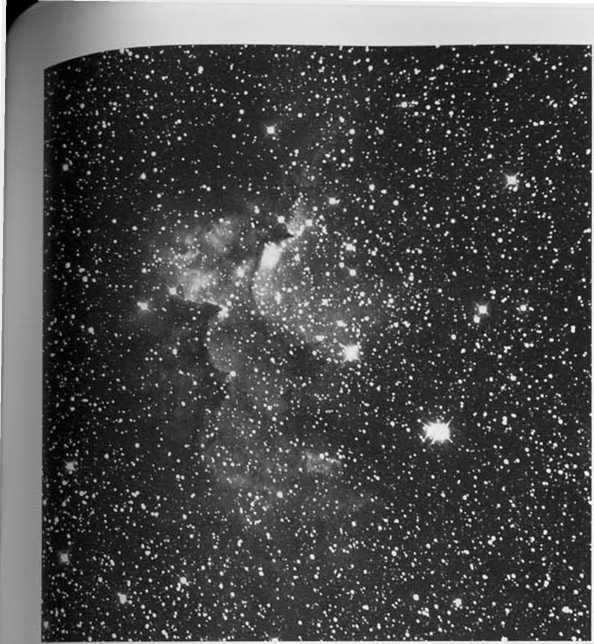
Figure 8.2
While scanning Cepheus, look for the star cluster NGC 7380. (North is to the upper right.)
NGC 6946. This spiral is easily seen in even small telescopes. It shines at 9th magnitude and is roughly 10' across.
Tucked in the southeastern corner of Cepheus is the bright cluster NGC 7380. Its 50 stars (Figure 8.2) are scattered over an area about 10' in diameter. Having a total visual magnitude of 6.4, NGC 7380 can be readily seen in binoculars. Small telescopes will reveal a conspicuous double star, magnitudes 7.6 and 8.6, at the southwestern edge.
The most northern galactic cluster in the sky, NGC 188, is also one of the oldest known, 14 to 16 billion years*. It is located just 4° south of Polaris and 1° south of - Ursae Minoris — a bright star that was engulfed by Cepheus when the constellation boundaries were redefined by Eugene Dclporte in 1930. NGC 188 is 15 across, so use low power. It contains some 150 stars, most of which are fainter than 13,11 magnitude. Despite a total magnitude of 9, it is virtually invisible with poor lransparency, or in too feeble a telescope. On fine nights I see it as a ghostly glow
Gweni/y the age of the universe is estimated at 12-14 billion years, while the ages of some of the oldest 4rs in globular clusters are estimated to be around 13—15 billion years. As astronomers work on a more Ccu'ate determination of the ages of stars and the universe, this seeming paradox of stars older than the nive^ is being resolved. in thc 4-inch Clark refractor. In his Celestial Handbook, Robert Burnham j describes the appearance of NGC 188 in a low-power 6- or 8-inch telescope— ’ large but dimly luminous spot with only a few of the brighter members show’ individually." Although it shows nicely in an 8-inch telescope, you will have"18 search it out from a few bright stars nearby that some people mistake fOr tk° cluster. Back in Kansas, on a night when the naked eye reached magnitude 7 5 6 counted several dozen stars in NGC 188 with my 10-inch reflector at 86x
Inside the Cepheus pentagon is a more challenging open cluster, NGC 714-) John Herschel described it accurately as “a large, rich, loose cluster of stars Of magnitude 10 or 11.” To me it seemed an evenly spread layer of small stars. Lo0). for some faint stars in a patch 10' across. Finding them can be a problem, for the brightest single member (except for two obviously foreground stars) has been measured as visual magnitude 12.4. Hence, NGC 7142 does not show in a 2-inch finder, and I generally search with the main telescope after plotting the cluster on a detailed chart. High magnification helps after this cluster has been found One fine night in Connecticut, the 4-inch Clark at 40x showed an even glow in which a dozen stars twinkled. Since lOOx revealed more, 1 put on a Barlow lens to double the power again, and saw a host of minute stars.
Open cluster NGC 7510 in Cepheus is about 9th magnitude and 3' across. Of it, Canadian amateur Dunstan Pasterfield writes, “Very easy to find, an attractive object framed by surrounding stars. It has an unusual shape, like a very thin arrowhead that is slightly bent at the tip. A hint of nebulosity. About 7-10 stars — delightful thing.” Have others seen any nebulosity here? Could the impression of a glow come from faint stars in the cluster not seen directly?
Though the north celestial pole lies in the constellation Ursa Minor, Cepheus reaches up to declination 88'/2°. Most of its bright stars are 20° or 30° from the pole, in the Milky Way where it crosses the southern part of the constellation. "Here one might expect many clusters and planetary nebulae," Scotty wrote, "especially since neighboring Cassiopeia has a profusion of them." But Cepheus is relatively poor in traditional deep-sky wonders. It has no dramatically bright galaxies (only one is plotted on Sky Atlas 2000.0) or any globulars. And, surprisingly, rich open clusters are not as profuse as one would expect from a Milky Way region. In all, one could say that Cepheus has few good objects. But "good" is a relative description, as Scotty reveals here. Remember, even a faint object can be a good one if it presents a challenge.
Thanks to their never setting from mid-northern latitudes, some of favorite double stars within 15° or so of the pole can be inspected whenever the mood strikes, or shown to a friend who drops in. The circumpolar doubles range from difficult binaries to glorious objects at low power.

aris itself is a wide optical pair, first seen as double by William Herschel in Its two stars, magnitudes 2.1 and 8.9, are 18" apart. Argument still goes on ^ut the smallest aperture needed to show the companion. Long ago, William mwes suggested it as a test for a 2-inch, but it has been seen in smaller telescopes. Miy not make some systematic tests with a graduated set of cardboard jiaphragms on your own telescope?
An easy pair that can be split even in big tripod-mounted binoculars is Struve )694 (also written as X 1694) in Camelopardalis. It consists of a 5.3-magnitude star ind a 5.8-magnitude companion, separated by about 22" and moving in parallel paths in space. The “I” prefix (often seen in star catalogs) means that a double star jS listed in Wilhelm Struve’s famous catalog.
Look in Cepheus for Struve 2923, an unequal 9" pair. Its components, of magnitudes 6.3 and 9.4, should be resolved by 2- or 3-inch telescopes. This, too, is a common proper motion pair. Half a degree away is a difficult binary that makes an interesting object for larger amateur instruments: Struve 2924. This system of 6.6 and 7.0 magnitude stars has an orbital period of 226 years, according to the calculations of Wulff D. Heintz. The true orbit is actually nearly circular, but the apparent orbit is a highly foreshortened ellipse. Struve discovered this pair about 1830. when the separation was 0.8". In the 1930s it had closed to less than 0.2", and I've seen it widened to 0.5".
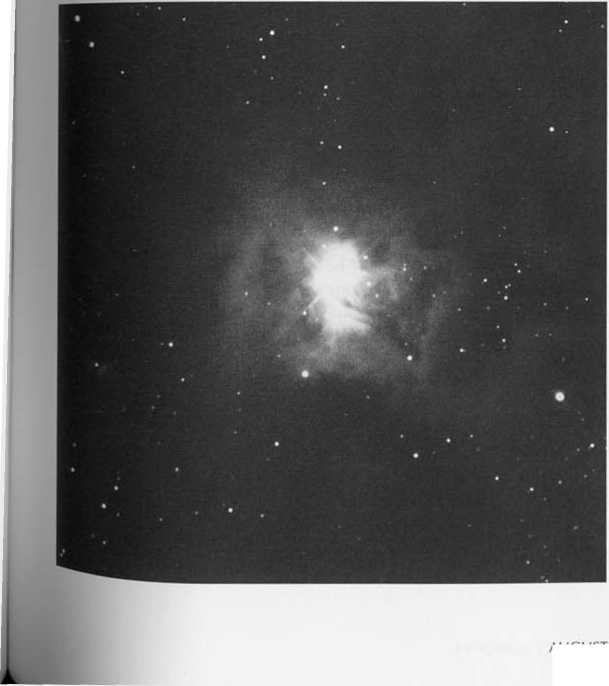
Figure 8.3
Binocular and small-telescope users will find the nebula NGC 7023 to be an interesting view.
NGC 7023 is an object that Sky Catalogue 2000.0 calls “one of the bright reflection nebulae,” an encouraging description to say the least. It is centered^ a 6th-magnitude star that is easily seen in binoculars (Figure 8.3). From my e°n liest days as an observer I have notes that refer to the nebula as “real bright '■ and question why it is not plotted in Norton's Star Atlas. I suspect it is an e object for big binoculars.
Figure 8.4
Planetary nebula NGC 40 in Cepheus measures about one light-year across. It has an extended halo (not seen here) probably formed by the mass ejection of gas from its atmosphere.







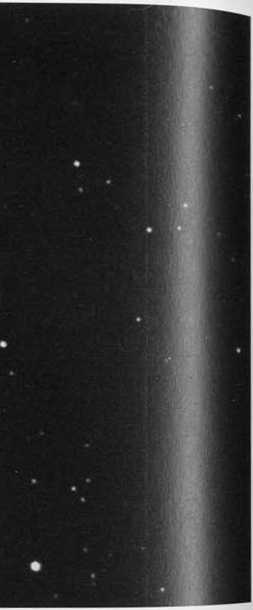
Two rather difficult nebulae, on the other hand, are NGC 40 and IC 1470. NGC 40 is a lOth-magnitude planetary about 0.6' in diameter (Figure 8.4). Though located in a region devoid of bright guide stars, it was spied with my 5-inch Apogee telescope. IC 1470 lies on the galactic equator near the Cassiopeia border. On a good night it should be an easy object for an 8-inch telescope. Tom Reiland. of Glcnshaw, Pennsylvania, was observing IC 1470 with an 8-inch f/5.3 Newtonian when he happened upon a smaller and fainter object about 12' south and slightly west of it. At first he thought it might be a comet, but increasing the power from 54x to 130x revealed half a dozen stars spread across 30" with a hint of nebulosity. IC 1470 is now regarded as a diffuse nebula, though at one time it was thought to be a planetary. Using a pair of 5-inch binoculars, I searched quite a while before locating this faint object, which is only 1' across. But once found-it was relatively easy.
r|,ara. California. A recent letter tells of his surprise when his observations of ■ gaseous nebula in Cepheus showed more detail than the famous Sir John jjerschel saw. This object is NGC 7129. Herschel described it as “a very coarse . |e star involved in a nebulous atmosphere; a curious object. The nebula is xtremely faint and graduates away.” Tire stellar triangle is about 2' in extent. Thomson, however, has seen five stars. He writes: “At 70x, three stars are visible ■ the nebulosity. A in the south following part. B in the south preceding. The bird fainter star, C, is northeast of A. With 160x, a fourth star was visible slight-I southwest of C. Using 222x, I could glimpse a fifth star just southeast of A. All five components were readily visible with 333x.”
The 18%-inch speculum-metal mirror used by John Herschel for his observations in 1829 was perhaps equivalent to a modern 12-inch aluminized mirror. One indication of Thomson’s observing skill is his independent rediscovery of the very faint galaxy NGC 5296 in Canes Venatici, which was missed by both William and John Herschel and was first noted by Lord Rosse with his 72-inch
in 1850.
1 looked at NGC 7129 with my 4-inch Clark refractor on a night so clear that the Triangulum Galaxy M33 was intermittently visible to the naked eye. At 120x, the nebula and John Herschel’s three stars were clearly seen, but even with 310x there was no trace of the other two stars.
"They are ephemeral spheres that shine in pale hues of blue and green and float amid the golden star currents of our galaxy." What Scotty was describing, of course, are the planetary nebulae, which, he extolled, "are often the delight but also the bane of amateur astronomers." Bright planetary nebulae are uncommon, and planetaries of all shapes are rare because their lifetimes are short. The Messier catalog contains only four of them — M27, M57, M76, and M97. To date, only about a thousand are known, and perhaps only a hundred of them are suitable for amateur telescopes. The most famous planetary in the heavens is unquestionably M57, the Ring Nebula in Lyra.
To some people, the ethereal gas bubbles of planetaries have a compelling pull all their own. They float on the foam of the Milky Way like the balloons of our childhood dreams, so delicate they appear. If you want to stop the w°rld and get off, the lovely planetaries sail by to welcome you home.The Ring Nebula, M57 in Lyra, is one of the best-known objects in the summer sky figure 8.5). It was discovered by the French astronomer Antoine Darquier in
9 while comet hunting with a 3-inch refractor. He described it as “a very u nebula, but perfectly outlined; as large as Jupiter and looks like a fading Planet.”
Figure 8.5 MS 7 in Lyra appears ringlike because we are looking down a barrel of gas cast off by a dying star thousands of years ago.
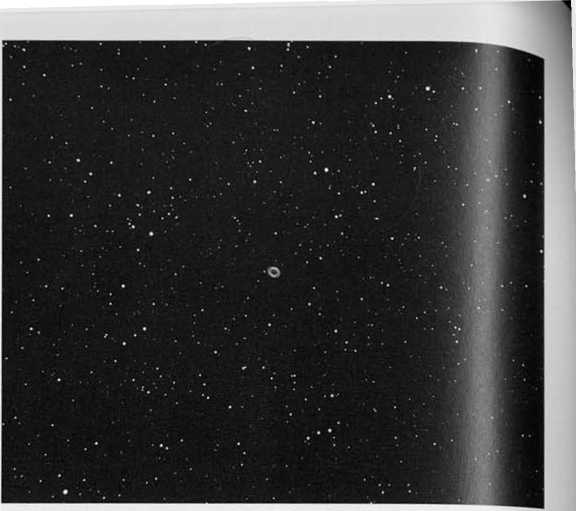
By Herschel’s time its “smoke-ring” form was known and justly admired. William Herschel thought it to be a ring of stars just beyond the resolution of his telescopes. His son John first called attention to the fainter nebulosity which fills the interior of the ring, likening it to gauze stretched over a hoop. In Ireland, Lord Rosse used his 6-foot speculum-metal reflector in the 1840s to detect structure in M57’s ring, but curiously he does not mention the central star first seen with a smaller telescope by the German Friedrich von Hahn around the year 1800. (Rosse does say that he never really viewed M57 under excellent conditions when his 6-foot reflector was working at its best.) All this reminds us of the superior optics which today’s amateurs enjoy, for under good conditions the central nebulosity and star can be glimpsed in apertures as small as 6 and 10 inches respectively.
The Ring Nebula differs from most planetaries by the almost perfect sharpness of its outlines, and the completeness of the ring form, in contrast to such objects as the Dumbbell Nebula, where visual scrutiny would never suggest the typical planetary construction. However, long-exposure photographs of M57 show a second ring outside the first, of a fragmentary and curdled appearance. Also designated NGC 6720, M57 is easily found halfway between Beta (0) anc* Gamma (y) Lyrae. It is oval, 80" by 60", and is of the 9th magnitude visually.
For early observers, the trick was to see it as a smoke ring with a dark core. As the average amateur’s telescope became larger and eyepieces better made, the ring was no longer a challenge, especially since this object bears magnification well. Appearing a bit more than 1' across, M57 looks like a 9th-magnitude star m finders.The Apogee telescope shows the ring as very bright, but no other detail • visible. At powers of 250x and up. a curious effect takes place. The oval outline of M57 takes on a *emon shape with the ends of the oval appearing rather pointed They also appear more diffuse and wispy. A power of 600x, however, is none 0 great if there is sufficient aperture to support it. Even at high magnification, thc interior of the nebula retains a thin film of haze that can show some structure.
I have probably looked at the Ring Nebula with a greater variety of telescopes than I have at anY other heavenly subject. One of my best views came with the 12-inch f/17 Porter turret telescope on Breezy Hill in Springfield, Vermont, the ite of the annual Stellafane convention. At 200x the ring was bright, slightly elon°ated, and of uniform luminosity. An increase to 600x changed the picture dramatically. No longer was the smoke ring evenly bright. Instead, two sides of the ring were made up of curved and twisted streamers. The oval now had pointed ends, and the central region was full of turbulent detail.
The sky above Breezy Hill that night was superb, with the naked-eye magnitude limit approaching 7. M33 could even be glimpsed without optical aid (a favorite test of mine for those rare nights of really excellent observing conditions).
So what does it hold for the explorers of the wilds? In 1874, Edward S. Holden studied it with the 26-inch refractor at the U. S. Naval Observatory in Washington, D. C. He commented that the interior of the ring appeared to be filled with “glistening points” of light. TTiis report remained unique for about a century. In 1979,1 was looking at the Ring with the Porter turret telescope using 600x.To my surprise I, too, saw a scattering of faint stars across the center of the nebula and against the brighter parts of the ring. However, these stars were not visible in the 20-inch Clark refractor at Connecticut’s Wesleyan University. But that telescope is plagued by light pollution. The problem today is to see the gossamer bands of nebulosity that cross the planetary’s core. They are visible in the Porter telescope. This instrument is particularly noteworthy for its high-contrast views of the planets and deep-sky objects.
On a top-class night, a 12- or even 10-inch telescope can show the planetary’s central star. In moments of exceptional atmospheric conditions a 12-inch or larger instrument may reveal a scattering of stars across the central vacancy and even amid the ring itself. However, stars do not spread beyond the outer edge. 1 ve checked several photographic atlases and noticed a definite lack of faint stars around M57. From my own dark-site observations I know that the edge of the Milky Way does cross this region. Could there be a dark halo surrounding the glowing ring that blocks the view beyond? If so, why do we see stars inside the ring?
For those of you interested in viewing the central star of M57, it is worth not-ln8 that over the years, estimates of its magnitude have ranged from 14.5 to less than 16. Although some have suspected the star as being variable, the data arc far hom conclusive, as anyone who has tried to estimate the magnitude of a star embedded in nebulosity knows. Needless to say, the central star is very difficult to ®bnipse. It should be a routine object for a 12-inch telescope, but often cannot be Seen with a 17'Z-inch. 'fire usual technique of increasing magnification to darken thc sky behind a faint star docs not work as well as expected. This is due to the faint nebulosity filling the interior of the ring and reducing the star’s contrast with its background. A telescope's focal ratio may play some part in rendering the star visible. At f/17 the 12-inch Porter turret telescope usually makes easy Work of M57’s central star, while significantly larger apertures have difficulty.
Try also looking for three galaxies that are near M57; one is even in the same field of view. The brightest of the three, NGC 6713, lies just a bit more than 1» northwest of the Ring. Albert Marth discovered it with the 48-inch speculum metal reflector that William Lassell constructed in the early 1860s on the Mediterranean island of Malta. I wouldn’t be surprised if a modern 16-inch reflector, with its high-efficiency optical coatings, had a total light-gathering power similar to that of the speculum-metal mirrors in Lassell’s telescope. The NGC 2000.0 catalog lists NGC 6713 as photographic magnitude 14, so visually it might appear a little brighter — say 13.2. Another galaxy is NGC 6700. located about I/20 southwest of M57. Edouard Stephan discovered this one with the 31-inch silver-on-glass reflector at Marseilles Observatory in France. NGC 2000.0 lists it as photographic magnitude 14 as well, so it should appear similarly brighter visually.
Much more challenging is a tiny 15th-magnitude barred spiral discovered by E. E. Barnard. IC 1296 lies just 5Z northwest of the ring. I do not know of any amateur sightings of this galaxy.
Next to M57, the Dumbbell Nebula (M27) is the sky's second most sought-after planetary nebula. Its ghostly green orb is really the glow of dimly lit shells of gas blown off an aging star shining weakly at the nebula's core. As the shells expand, they fade, and only a few tens of thousands of years pass before their ghostly shapes disperse into space. The extreme limit of visibility of the expanding shell and of its tiny illuminating source, a white dwarf star, intrigued Scotty. Naturally, he loved to share the visual mysteries of planetaries with his readers. And he couldn't resist tossing out a planetary nebula challenge or two to those who would pursue them. The Dumbbell was not lacking in challenges for Scotty or his readers.
The August sky contains many delightful planetary nebulae — ephemeral spheres of blue and green gas that float amid the pearly star currents of the Milky Way. Certainly one of the most observed is the Dumbbell Nebula, M27, m Vulpecula (Figure 8.6). Binoculars will show it, but no instrument ever exhausts the additional detail that may be seen as larger telescopes are turned to it.Thirty years ago my mail was filled with complaints from amateurs who had difficulty finding M27, but I haven't heard such remarks for the past 10 years. This is a tribute to thc growing observing skills among the fraternity of today’s amateurs. H
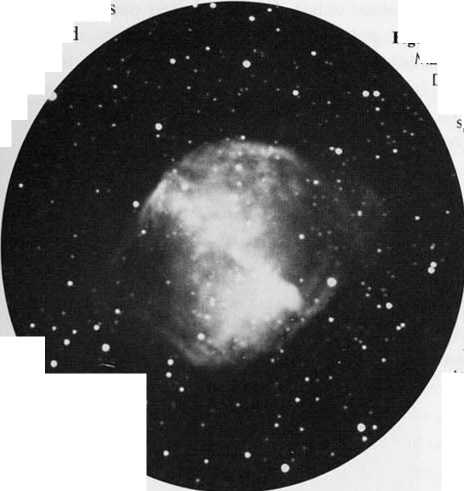
Figure 8.6
M27, the famous Dumbbell Nebula, was spotted in 1764 by Messier and was i the first I planetary I nebula I discovered. Its light takes about
1,000 years to reach us.
. iu’re having trouble locating it, here's one method that works well for me. Set ' ur finder on Gamma (y) Sagittae, the head of the celestial arrow. Sweep about 50 north and you should see an M-shaped pattern of stars composed of 12,13,14, 16 and 17 Vulpeculae; this group is more conspicuous to the eye than most star chafts V°u to be'*eve- ^27 is just !4° south of the M’s central star.
The noted English observer Thomas W. Webb saw M27 as “two hazy patches in contact.” and it is this appearance that gives rise to the nebula's popular name. However. I don't believe that many observers see the dumbbell shape without having a bad wrench to the imagination. John Mallas. who observed with a 4-inch refractor, drew M27 as a rectangle twice as long as it is wide. With my 4-inch Clark refractor, a quick look reveals the planetary as two cones with their apexes in contact. After finding the best eyepiece for the evening's sky conditions, and by using averted vision, 1 usually see the faint nebulosity between the brighter parts of thc cones. By gently rocking the telescope back and forth — which sets the W planetary in motion and helps the eye capture the faintest extensions of light — I found the end result is a full circle of light, just as
one would expect of a planetary. The luminosity of the interior varies greatly, but the circular outline remains firmly fixed.
It is hard to assign a “best” type of telescope for viewing M27. My 5-inch Apogee telescope with a fixed power of 20x shows it as a bright sphere with the dumbbell shape rather mild. My 10-inch, f/8.6 reflector shows M27 much better at 300x by means of a Barlow lens than at the same power with a short-focus eyepiece. The latter left the sky gray, and contrast with the nebula was poor. The Sorter turret telescope reveals intricate inner detail and a strong edge all the way around the nebula. M27 is often cataloged as having dimensions of 8' x 4', but as Mentioned above, it really appears round and about 8' across, especially on phonographs. Its total brightness is equal to that of a 7.6-magnitude star, and there is a l^h-magnitude central star that is a difficult object for most amateur telescopes.
The fact is, this fickle planetary has as many shapes as there are observers its appearance can even vary from minute to minute as observing conditio ’ change. Several years ago I had a good lesson in just how critical a role the atmosphere plays in observing faint, nebulous objects. During May 1983. ] \v.r in western Pennsylvania when Comet lRAS-Araki-Alcock raced across the sk from Draco to Cancer. It moved so swiftly that within minutes 1 could detect change in its position with the naked eye. What really interested me, however was the coma’s diameter. At times it was 2° or 3° across, while at other times it was fully 6°. This must have been due to atmospheric changes that otherwise would have gone unnoticed.
According to Burnham’s Celestial Handbook, M27 appears to be expanding at the rate of 1" per century. If this rate has remained constant, then the nebula is perhaps 48,000 years old — if it has slowed over the years then the object could be much younger.
So the test with M27 is not in seeing it — the glowing bubble, as I mentioned, should be easy in finders if the sky is dark — but rather in what is seen. Can vou trace the faint wisps of nebulosity from the ends of the bar to where they meet above and below it?
The next time you're out under a very dark sky, look up at the Milky Way. How wide is it? The answer is not as simple as it seems. The answer depends not only on where you look but how you look. It also depends on the conditions and state of the atmosphere and on your own physical condition and eyesight — all factors that vary with time. Thus, the "shores" of this Galactic River can be as hard to define as the extended coma of a comet. Even star charts do a poor job of tracing the visual breadth of this, the sky's largest deep-sky wonder. But the problem doesn't end there. The same difficulty we experience in this simple exercise with the naked eye applies also to the telescopic observing of nebulae, especially of the planetaries, whose expanding shells gradually fade until they blend with the sky background. Scotty was excited about this visual conundrum, which he explains here.
This may sound foolish, but all my life I’ve wanted to find the edges of the Milky Way. Obviously our galaxy can’t go on forever. It must stop at some point. But where? On any clear night I can clean my glasses and wander out to a dark corner of my yard with a ruby-colored flashlight and star charts in hand. After letting my eyes dark-adapt, I can carefully plot the apparent edges of the Milky Way (Figure 8.7). The rub is, however, if I repeat the process two hours later, I usually get a border that is nowhere near my original one.
Books and atlases don’t seem to offer much help. Norton's Star Atlas plots the boundaries of the Milky Way in great detail, but they’re not what I see. The atlas’s preface concedes that the boundaries arc difficult to define, and that the outline on the charts is based on observations by the 19th-century astronomy popularizer Richard A. Proctor. Thus, my 1957 edition of Norton’s uses data about a century old!
WilTirion's Sky Atlas 2000.0 might seem like a better bet since it was first published in 1981. The Tirion charts show more twists and turns at the edge of the Milky Way. but here again they are often quite different from what 1 see. The introduction to this atlas notes that the outline shown is one that the Dutch astronomer Antonie Pannekoek prepared in the 1920s. I’m not sure how he derived it. but it is probably a combination of photographic and visual observations. both of which have their limitations.
Over the years my conviction has been growing that the atmosphere is really what determines the limits visible to the eye, and the atmosphere can change on a time scale of minutes. In late 1985 I set out to watch Halley’s Comet with my 5-inch 20x Apogee telescope when it was near the Pleiades. At 11:30 p.m. sweeping did not turn up the comet; I had to revert to charts to find it. The cosmic
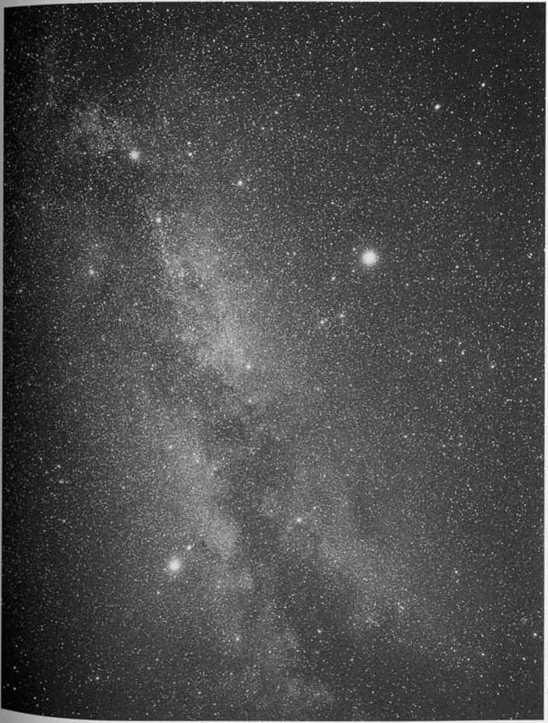
Figure 8.7 The Milky Way is an awe-inspiring sight on a cloudless dark night. Here, Deneb (upper left), Vega (right) and Altair (lower left) seem to frame the galaxy's star clouds.
visitor looked like a 7th-magnitude star with barely a trace of a blur at its edgCs At midnight I looked again and found a whole different object before me. Th comet was easily swept up and the bright coma appeared about 1° across R 12:20 a.m Halley had returned to being a slightly nebulous star.
All this is worth remembering by the deep-sky hunter in search of faint galax ies, supernova remnants, stray H II regions, and diffuse planetary nebulae. You can use every trick in the book to press your telescope to its limit, but the atmos phere is still going to be a highly variable "filter." 1 call it Houston’s Uncertainty Principle, and it confounds your ability to predict the magnitude limit of a gjVen telescope to no better than one full magnitude.
In my flirtations with the boundary of the Milky Way, I have spent a lot of tintc looking at the region around Lyra. The Tirion charts show the Milky Way's edge crossing the lower section of the lyre, including the whole area between Beta (p) and Gamma (y) Lyrae and its resident deep-sky showpiece M57,the Ring Nebula.
Edouard Stephan also discovered several star clusters here, including one involving the bright, naked-eye double star Delta (8) Lyrae. This group is bright but sparse, having only a dozen or so stars in a 2O'-wide area. It is easy to see in binoculars. The bright double may lead the eye astray and be the reason so few observers seem to be aware of the rest of this cluster.
From Delta Lyrae it’s only a short skip to the nearly equilateral triangle of stars Epsilon (e), Zeta (Q, and brilliant Alpha (a), or Vega. Few amateurs seem to know that all three, and not just Epsilon, are double stars. Epsilon (e) of course, is the famous Double Double, whose bright components are separated by 3Z' and create a test for naked-eye acuity, much more so than Alcor and Mizar in the handle of the Big Dipper. As a youth I could split them easily, but I have not been able to do this for several years. Each component is itself a pair — the separations are currently 2.6" and 2.3" — well within the range of a 3-inch telescope.
I’ve never met an amateur who claims to have resolved Vega. Perhaps most are not aware that it has a companion. Brilliant Sirius and Antares are well known as binaries, but unlike them Vega is just an optical pair with no physical connection between the components. At present the 9.5-magnitude companion lies about 1' south of the magnitude 0 primary. The glare will make this a difficult pair at best. Don’t be confused by another 9.5-magnitude star 2' northeast of Vega.
The third member of the triangle, Zeta, is an easy pair. The 4.3-magnitude primary has a 5.9-magnitude companion YZ to the southeast. But a real challenge would be to look for a 15th-magnitude star cataloged as being just 25" northeast of the primary. It would be interesting to know the accounts of your adventures in looking at these stars.
The tiny diamond-shaped form of Delphinus is popular among summer stargazers. (My wife, Donna O'Meara, loves to spot it whenever she's looking up on a warm
r summer's eve.) Like the Pleiades, this small but tight grouping of moderately bright suns has the power to draw attention to itself. "Unlike many of the large consfellat’ons t*iat date ,o antiquity," Scotty wrote, "most smaller asterisms are the llindiwork of celestial cartographers from the 17th and 18th centuries. There are xceptions, however, and one of my favorites is Delphinus, the Dolphin." Scotty explained that his love for Delphinus was a long-lived one. "I became well acquainted with Delphinus when I joined the American Association of Variable Star Observers in the 1930s and started doing 'serious' astronomy," he wrote. Indeed, the first variable star he would log in his record book would be Z Delphini. The constellation's 189 square degrees also offers a fine blend of stellar and deep-sky wonders, making this delightful constellation a naked-eye, binocular, and telescopic attraction.
Summer lies hot and tranquil on the land. The gigantic storms of winter and the turbulent atmosphere that accompanies them are only memories now. At this time of year the seeing is steady all night.
West of the meridian in late evening lie the great star fields dancing with the brilliance of Sagittarius, Scorpius, and Scutum. The eastern sky, however, is a virtual desert of bright stars. The Great Square of Pegasus has little to offer the naked-eye observer, and Equuleus is likewise dim. On nights when a bright Moon floods the heavens with its golden light, the eastern sky appears almost devoid of stars. Near the meridian, however, is the small constellation Delphinus the Dolphin (Figure 8.8). To the eye it appears as little more than an overgrown asterism, but it contains some compelling objects for anyone with a telescope.
Delphinus has a distinctive diamond of stars forming the creature’s head. While these have never received official cluster status, there is some question as
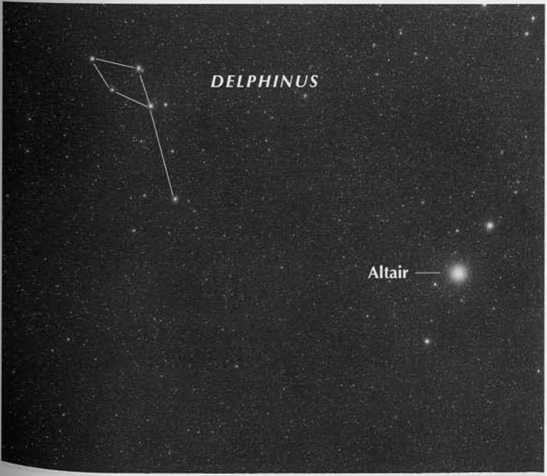
Figure 8.8
The constellation Delphinus looks like a diamond with a tail and can be found about 12° northeast of brilliant Altair, the brightest star in Aquila, the Eagle.
to whether several of them are physically related to one other or to fainter star.-in the immediate area.The constellation is thinly covered with the outliers of th Milky Way and galactic dust as well.This blocks our view of the universe beyond so the area lacks the profusion of galaxies that are visible farther to the east
Nevertheless. I developed a fondness for Delphinus years ago when I began making observations for the American Association of Variable Star Observer The area was rich in variables, and I could make half a dozen estimates in less time than it took to search out a single star in a less crowded field.
In my youth I knew Delphinus as Job’s Coffin, a moniker whose origin even such star-name experts as Richard H. Allen acknowledged as being lost in the sands of time. Although my library is limited, the term appears in a copy Of Elijah H. Burritt’s Geography of the Heavens, published in the 1830s. I suspect that the name was just one of those fashionable tags that caught on among skywatchers. Today we’re surrounded with similar fads drawn from popular music television commercials, and adolescent attire. (Can anyone pinpoint the source of ripped jeans being a fashion statement?)
On a similar note, at one Stellafane convention in Vermont I heard a 20-year-old amateur refer to the star Betelgeuse as “beetle-juice." While many readers are familiar with this term, I never encountered the pronunciation before World War II. In fact, I wonder if it originated with an Army Air Corps cadet at a military base where I taught celestial navigation during the war. One of the cadets was having trouble saying Betelgeuse, so he changed it. Before long even the experienced navigators had picked up the altered pronunciation.
Delphinus has several noteworthy double stars. Gamma (y), at the northeast corner of the diamond, is a beautiful pair with a 4.5-magnitude primary and a 5.5-magnitude companion some 12" to its west. Although the pair is physically connected, the orbital period is so slow that the position angle of the two stars has barely changed since it was first measured by Wilhelm Struve in 1830. The pair has long been known for its contrasting colors, but there is some question as to exactly what the colors are — different observers report different combinations. All agree, however, that Gamma Delphini is a splendid sight in small telescopes.
In the 1930s I was at the University of Wisconsin and had access to Washburn Observatory’s 6-inch Clark refractor, used by Sherburne W. Burnham to observe double stars. One of the many doubles he discovered with that telescope was Beta (P) Delphini, at the southwest corner of the diamond. The components have magnitudes of 4.0 and 4.9, and, though an extremely challenging object for amateur telescopes (the pair’s separation varies between 0.2" and 0.65"). Beta Delphini has an orbital period of only 26.6 y cars. For about half of the orbital period of the pair, the stars are separated by about 0.30". By the turn of the century the stars will be nearing maximum separation, the most likely reason Burnham succeeded where other great double-star observers had failed is that he chanced upon the pair when it was near its maX' imum separation in August 1873.
In 1950 I examined the star with my newly completed 10-inch reflector. Then separation was near a maximum of 0.6" with the companion due north of the ’marV- My first attempts to split the pair failed because the companion was lost ■ the diffraction spike caused by the telescope's secondary mirror holder. Success came only after rotating the tube 45° in its cradle to shift the position of (he spike. Ten years later the companion had moved roughly due east of the primary a°d t'ie separation had shrunk to a minimum of 0.2". I was unable to detect even a slight elongation of the double star’s image. Try experimenting with masks to determine the smallest aperture which will show the pair.
Alpha (a) Delphini is a challenging double for a different reason. With a sep-aration of almost 30" (two-thirds the apparent diameter of Jupiter), the pair would seem to be within reach of the smallest telescope. But at magnitude 13.3, the secondary is 9'/? magnitudes (more than 6,000 times) fainter than the primary. It's located to the southwest. An old trick is to place a bright star just outside the field of an eyepiece when searching for faint companions.
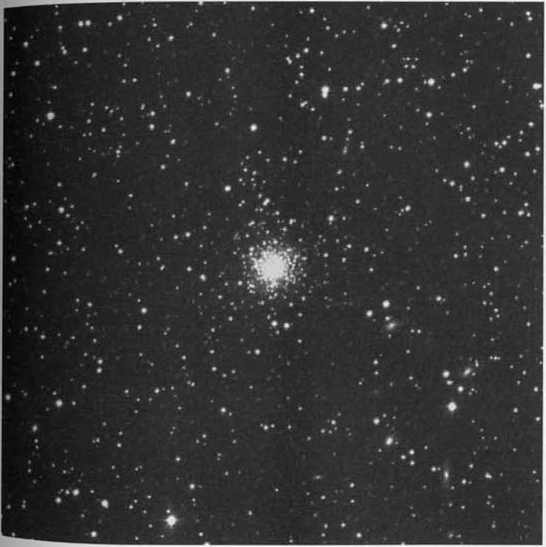
Figure 8.9
Distant, shimmering NGC 7006 is one of the most remote globular clusters that appear to swarm around the Milky Way Galaxy.
The interesting globular cluster NGC 7006 lies about 3!6° due east of Gamma (?) Delphini. If you have a motorized drive, switch it off, set your telescope on Gamma. and 15 minutes later the globular will be in view (Figure 8.9). Though readily detectable in a 3-inch instrument, it is small — 1.1'in diameter — and so concentrated that it may at first be mistaken for a lOth-magnitudc star. Although a relatively easy object for a 6-inch telescope, this cluster is among the most distant globulars known, located more than 110,000 light-years from Earth. l_ar telescopes may show it with a clumpy appearance, but I doubt it can resolved in any amateur instrument. NGC 7006 affords an interesting contr^ with the nearby great globular cluster Ml5, in Pegasus, which can be seen with thc naked eye.
Somewhat easier is the globular NGC 6934. More than 5' in diameter and shining with the total light of a 9th-magnitudc star, thc cluster can be glimpse in binoculars. Because of its setting, I find it a particularly pretty object for rich field telescopes. (Figure 8.10)
Figure 8.10
Another globular cluster easily seen in small telescopes or binoculars is NGC 6934. Through larger telescopes, individual stars can be seen around the edges and near the concentrated knot of stars at the center.
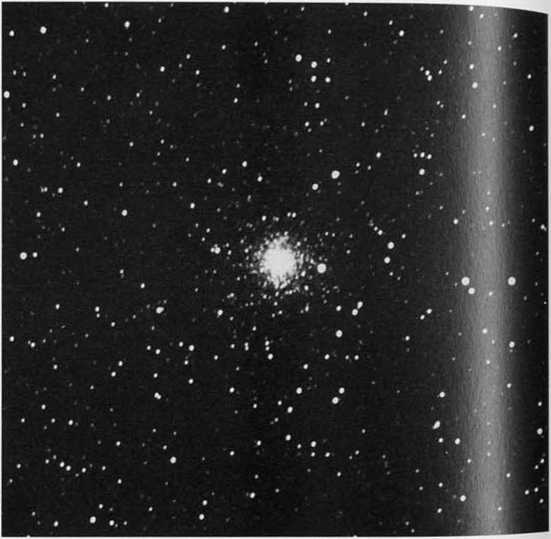
NGC 6905 is a planetary nebula situated in a coarse clustering of stars in the very northwest corner of Delphinus. William Herschel discovered it in 1782. and his son John Herschel speculated on a possible connection between the nebula and the many faint stars around it. Its 12th magnitude elliptical disk is about 45 in diameter (roughly the same size as Jupiter’s disk) and is relatively easy for a 6-inch telescope under good skies. On one of those exceptionally rare nights when the Connecticut atmosphere forgot that its main function is to depress amateur astronomers, I fished out NGC 6905 with my 4-inch Clark refractor. At least a 10-inch telescope is needed to make out the 14th-magnitude central star. Barbara Wilson of Houston. Texas, reports seeing a lot of internal structure i" NGC 6905 with a 20-inch reflector. The central star has an extremely high sur face temperature of about 100,000° Kelvin.
fxlGC- 6891 is a small object about 12" in diameter, roughly three times small-,r than NGC 6905. At low magnifications it looks almost stellar. The planetary .. |iSted in Sky Catalogue 2000.0 as being of photographic magnitude 11.7. but it seems brighter visually (other sources list it as between 9th and 10th magnitude). I have seen it front Connecticut with a 4-inch off-axis reflector. Observing with a 16-inch reflector from the Sonoran desert outside Tucson, Arizona, Ron Morales notes that NGC 6891 resembles an unresolved globular star cluster.
Unlike many authors,T. W. Webb took great pleasure in writing about rich star fields. These are not the discrete objects like star clusters and galaxies that interest most deep-sky observers, but rather wonderful starry vistas that are nothing more than chance alignments of random suns. Webb wrote about them simply because they were delightful to look at.
Philip Harrington has a similar attitude in his book Touring the Universe Through Binoculars. Accordingly, he lists several asterisms that are new to amateur observing guides. One such group involves 6th-magnitude Theta (0) Delphini. Harrington notes that there are about two dozen stars here of 9th magnitude and brighter that are visible in binoculars.
About 1 '/° southeast of Theta lies NGC 6956, a small galaxy discovered by William Herschel. It is about 2' across and, by my estimate, magnitude 13.2. While Herschel considered it “very faint” as seen with his 18Z-inch reflector, perhaps the telescope’s speculum-metal mirror was tarnished or thc sky conditions were unfavorable on that particular night. Today NGC 6956 can be held easily in a 4-inch refractor.
Although galaxies are sparse in Delphinus, NGC 6928 is the brightest member of a foursome located I1/’ south of Epsilon (e) Delphini. Its cigar-shaped disk is about 2' long and magnitude 12'/’. An 8-inch telescope should easily snare it on a good night, but a larger aperture will probably be needed to see its companions. They all lie within 14° of NGC 6928.
AUGUST OBJECTS
|
Name |
Type |
Const. |
R. A. h m |
Dec. o / |
Millennium Star Atlas |
Uranometria 2000.0 |
5 |
|
Alpha (a) Delphini |
** |
Del |
20 39.6 |
+15 55 |
1216,1217 |
209 |
BFt" |
|
Beta (0) Delphini |
*♦ |
Del |
20 37.5 |
+14 36 |
1217,1241 |
208,209 |
u TT"' |
|
Della (8) Lyrae |
♦ ♦ |
Lyr |
18 53.7 |
+36 58 |
1152,1153 |
117,118 | |
|
Dumbbell Nebula, M27, NGC 6853 |
PN |
Vul |
19 59.6 |
+22 43 |
1194,1195 |
162,163 |
TT" |
|
Epsilon (e) Lyrae |
*♦ |
Lyr |
18 44.3 |
+39 40 |
1132,1153 |
82, 83,117 |
3,8 |
|
Gamma (y) Delphini |
*♦ |
Del |
20 46.7 |
+16 07 |
1216 |
164,209 |
’TiT" |
|
IC 1296 |
Gx |
lyr |
18 53.3 |
+33 04 |
1152,1153, 1174,1175 |
— | |
|
IC 1470 |
BN |
Cep |
23 05.2 |
+60 15 |
1070 |
34,58 |
~3 ’ |
|
NGC 40 |
PN |
Cep |
00 13.0 |
+72 32 |
24 |
3,15 |
1,3 |
|
NGC188 |
OC |
Cep |
00 44.0 |
+85 20 |
2,5,6,1035 |
1,2 |
1,3 |
|
NGC2276 |
Gx |
Cep |
07 27.0 |
+85 45 |
1,3,4, 518,522 |
1 |
1 |
|
NGC2300 |
Gx |
Cep |
07 32.0 |
+85 43 |
1,3,4, 518,522 |
1 |
1 |
|
NGC6217 |
Gx |
UMi |
16 32.6 |
+78 12 |
1046 |
11 |
2 |
|
NGC6700 |
Gx |
lyr |
18 46.0 |
+32 17 |
1175 |
117 |
— |
|
NGC6713 |
Gx |
Lyr |
18 50.7 |
+33 57 |
1153 |
117 |
— |
|
NGC6891 |
PN |
Del |
20 15.2 |
+12 42 |
1242 |
208 |
16 |
|
NGC6905 |
PN |
Del |
20 22.4 |
+20 07 |
1217 |
163 |
9,16 |
|
NGC6928 |
Gx |
Del |
20 32.8 |
+09 56 |
1241 |
208, 209 |
— |
|
NGC6934 |
GC |
Del |
20 34.2 |
+07 24 |
1265 |
208, 209 |
16 |
|
NGC6939 |
OC |
Cep |
20 31.4 |
+60 38 |
1074.1075 |
32, 55,56 |
3__ |
|
NGC 6946 |
Gx |
Cep |
20 34.8 |
+60 09 |
1074.1075 |
32,56 |
3__ |
|
NGC6956 |
Gx |
Del |
20 44.0 |
+12 31 |
1240 |
209 |
— |
|
NGC7006 |
GC |
Del |
21 01.5 |
+16 11 |
1215 209, 210 |
164,165, |
9,16,17 |
|
NGC7023 |
OC+BN |
Cep |
21 00.5 |
+68 10 |
1061 |
32,33 |
3__, |
|
NGC7129 |
OC+BN |
Cep |
21 41.3 |
+66 06 |
1060 |
33 |
3___ |
|
NGC7142 |
OC |
Cep |
21 45.9 |
+65 48 |
1060 |
33 |
-___ |
|
NGC7380 |
OC+BN |
Cep |
22 47.0 |
+58 06 |
1071 |
58 |
3___ |
|
NGC7510 |
OC |
Cep |
23 11.5 |
+60 34 |
1070 |
34, 58 |
3 |
|
As! = Asterism; BN = Bright Nebula; CGx = Cluster of Galaxies; DN = Dark Nebula; GC = Globular Cluster; Gx = Goloxy, OC = Open Cluster; PN = Planetary Nebula; * = Star; * * = Double/Mulfiple Star; Vor = Variable Star | |||||||
AUGUST OBJECTS (CONTINUED)
|
Type |
Const. |
R. A. h m |
Dec. o / |
Millennium Star Atlas |
Uranomelrio 2000.0 |
Sky Atlas 2000.0 | |
|
Polaris, Alpha (a) Ur$ae Minor is___ polorissimo, NGC3172 |
** |
UMi |
02 31.8 |
+89 15 |
1,2,517, 518,1033 |
1,2 |
1,2,3 |
|
Gx |
UMi |
11 50.0 |
+89 07 |
1,517,518, 1034 |
1,2 |
— | |
|
King Nebulo, M57, NGC 6720 |
PN |
Lyr |
18 53.6 |
+33 02 |
1152,1153, 1174,1175 |
117 |
8 |
|
Struve 1694 |
*♦ |
Com |
12 49.2 |
+83 25 |
520 |
9 |
2 |
|
Struve 2923 |
*♦ |
Cep |
22 33.3 |
+70 22 |
1048 |
34 |
3 |
|
Struve 2924 |
*♦ |
Cep |
22 33.0 |
+69 55 |
1048 |
34 |
3 |
|
lheto (6) Delphini |
* |
Del |
20 38.7 |
+13 18 |
1241 |
209 |
16 |
|
Vego, Alpha (a) Lyrae |
** |
Lyr |
18 36.9 |
+38 47 |
1132,1153 |
82,117 |
3,8 |
|
Zeta iy Lyrae |
** |
Lyr |
18 44.8 |
+37 36 |
1153 |
117 |
3,8 |
Ast = Asterism; BN = Bright Nebula; CGx = Cluster of Galaxies; DN = Dork Nebula; GC = Globular Cluster; Gx = Galaxy; OC = Open Cluster; PN = Planetary Nebula; ♦ = Star; »♦ = Double/Multiple Star; Vor = Vorioble Star

